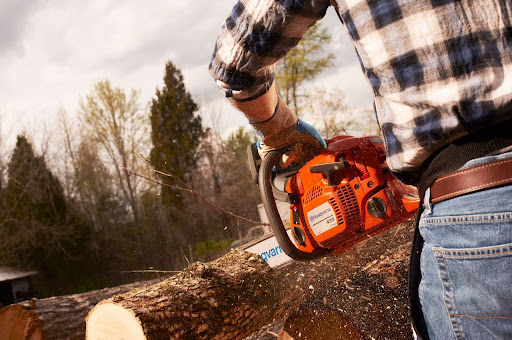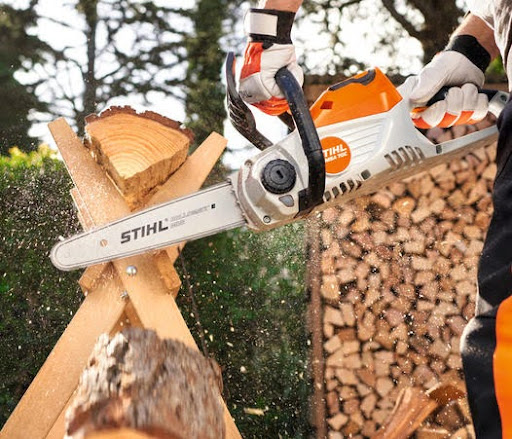
Chainsaws are powerful tools that make many cutting tasks easier and faster to complete. However, with great power comes great responsibility, especially when it comes to safety. For renters and buyers who are unfamiliar with operating a chainsaw, understanding how to use one safely is an absolute must before embarking on your project.
In this blog, we cover everything from the basics of chainsaw mechanics and the risks involved, to essential chainsaw safety tips. Plus, we’ll compare the benefits of both renting and buying your chainsaw.
How Chainsaws Work
Chainsaws are effective cutting tools because of their design, power, and the technology behind them. It all starts with the motor (whether electric or gasoline-powered) that drives a chain equipped with sharp cutting teeth around a guide bar at high speed. This design allows for rapid cutting through wood and other materials with minimal effort compared to manual saws.
Recognizing the Risks of Chainsaw Use
Despite their effectiveness, chainsaws come with inherent risks — a chainsaw can cause anything from minor injuries to severe accidents. Some of the more common hazards of chainsaws are:
- cuts and lacerations
- kickback
- flying debris
- noise-induced hearing loss
- exhaust fumes (for gas-powered chainsaws)
- fire
- falling objects
10 Essential Safety Tips for Chainsaw Users
No matter the chainsaw project, safety has to be a priority. The power that makes a chainsaw such an effective tool is also what makes it dangerous if you are not careful. Here are 10 safety tips to follow so that you can protect yourself and those around you when using a chainsaw.
- Wear Personal Protective Equipment (PPE): Chainsaw safety starts with safety gear. Safety glasses protect your eyes from flying debris, while foot protection shields against accidental slips or cuts. Head protection, like a hard hat, is also a good idea if you are working around potentially falling objects or large pieces of debris. Never underestimate the protection PPE offers.
- Check the Chain Tension: An improperly tensioned chain can lead to the chain slipping off the bar or breaking. So before you start your saw, check that the chain fits snugly against the bar but can still be turned by hand.
- Use a Chain Brake and Safety Chain: The chain brake is an important safety feature designed to stop the chain instantly in the event of kickback. Similarly, a safety chain, with its low-kickback design, minimizes the force if kickback occurs. Both are indispensable for safe chainsaw operation.
- Proper Chainsaw Handling: Holding your chainsaw with a firm grip and maintaining correct posture are key to controlling the tool effectively. A secure grip and balanced stance help manage the saw’s power and prevent accidents.
- Be Mindful of Fall Hazards: Clear your work area of trip hazards and make sure you have stable footing, especially when working in uneven or slippery conditions. You don’t want to fall while carrying or operating a chainsaw.
- Fueling Precautions: Never refuel a running or hot saw. Allow the saw to cool down first, and always refuel in a well-ventilated area, away from any ignition sources, to prevent fires.
- Start the Chainsaw Correctly: Place the chainsaw on the ground (so that it is stable), and use your foot or hand to hold it in place. Then start it up. This stops the saw from moving unexpectedly as it starts.
- Don’t Cut with the Tip: Avoid cutting with the tip of the chainsaw to prevent kickback. Cutting with the blade near the engine provides better control and minimizes this risk.
- Maintenance and Storage: A well-maintained chainsaw is a safer chainsaw. Regular cleaning, sharpening, and checking for wear and tear keeps your chainsaw ready and safe for the next use. You’ll also want to store your saw away from dust and moisture to protect its condition.
- Know Your Limits: Recognizing when a job is beyond your skill level or poses too high a risk is one of the most important things to keep in mind. For complex or dangerous tasks, consider hiring a professional.
The Advantages of Renting a Chainsaw

Choosing whether to rent or buy a chainsaw hinges on your specific needs, budget, and frequency of use. Renting a chainsaw is ideal for individuals with one-time or infrequent cutting tasks. It eliminates the need for a significant upfront investment. You also get access to a variety of models, each with their own benefits for certain jobs, so that you can select the right tool without the long-term commitment. Another plus of renting is that you don’t have to worry about maintenance.
On the other hand, buying a chainsaw makes sense for those who frequently engage in cutting tasks and require immediate access to the tool. Buying also means you don’t have to pay rental fees (which add up in the long run) every time you need to use a chainsaw.
Rentco – We’ve Got All Your Chainsaw Needs Covered
Being aware of the risks associated with chainsaw use and following our 10 safety tips will improve the safety of your project, but if you’re still trying to figure out the best way to get your hands on the chainsaw you need, Rentco has you covered.
We offer gas chainsaw rentals from top brands like Husqvarna. Battery and gas Stihl, and Husqvarna and Stihl chainsaws are also available for purchase at Rentco’s Tool Shed and select Rentco locations. Whether you decide to rent or to buy, you can trust that with Rentco, you’re getting quality equipment and great customer service. We also service all the brands we sell. Contact us today to place an order, get your chainsaw serviced, or make a chainsaw rental request. Let us provide you with the tools and guidance you need for success.